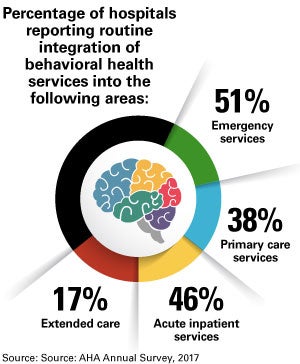

It’s Time for Holistic Patient Care

Treating the whole patient — both mind and body — in a well-coordinated system has become essential to health care’s mission. But integrating behavioral health into every aspect of patient care and coordinating and connecting with community resources across all points in the care continuum often prove challenging, research shows.
This helps to explain why only about half of hospitals routinely integrate behavioral health into emergency and acute inpatient services, and why even fewer hospitals do so in primary (38%) or extended care (17%), according to 2018 AHA Annual Survey data (based on 2017 operations).
 This lack of integration results in a more fragmented, higher-cost delivery system, with fewer access points for behavioral health patients. Yet, things are changing rapidly as hospitals and health systems are making a concerted effort to create a single system of care for physical and behavioral health.
This lack of integration results in a more fragmented, higher-cost delivery system, with fewer access points for behavioral health patients. Yet, things are changing rapidly as hospitals and health systems are making a concerted effort to create a single system of care for physical and behavioral health.
To accelerate progress, hospitals and health systems will need to make this a clinical and organizational priority. Health care executives must help lead this effort by ensuring that behavioral health services are part of their organizational mission and values, notes a new Market Insights report from the AHA Center for Health Innovation.
Report highlights include:
- A behavioral health pathway matrix providing a framework to assess integration level and capabilities in areas like provider network management, case management, patient experience and community partnerships.
- Case studies and models for how providers can improve the availability and coordination of behavioral health services in the emergency department, in inpatient and outpatient care and by extending access and care into the community.
- (New Tool) “Behavioral Health Integration Assessment: 26 Questions for Leadership Teams” – available exclusively to AHA members.
On the ED/inpatient side, for example, providers can make behavioral health assessments routine for all patients, either directly or through telemedicine services, and have appropriate processes in place for referral and treatment if needed. Electronic health record systems can be used to prompt clinicians to assess all patients for behavioral health issues and to ensure that the information gathered is shared with and addressed by all providers.
Provider organizations also can teach primary care physicians how to effectively use screening and assessment tools and educate them on what to do with the information. In addition, hospitals and health systems need to establish a continuum of services to which patients can be referred.
The AHA’s 2019 TrendWatch cites research that indicates integration can reduce the total cost of care and lead to better outcomes — essential components of succeeding in value-based care models.
5 Ways to Optimize Integrated Care
The report also urges health care organizations to leverage technology more effectively in care delivery and provides the following key insights for scaling and optimizing integrated care models:
- Start small: Don’t try to integrate behavioral health into the entire care continuum all at once.
- Leverage technology: Use technology to distribute your limited behavioral health resources more efficiently and equitably through telehealth and virtual consults.
- Collaborate smarter: Use electronic health information exchange and care management software to improve collaboration, handoffs and transitions in care.
- Get wise to patient apps: Familiarize caregivers with the growing number of consumer-facing behavioral health applications patients use, and help them use digital health tools, when appropriate, to manage their conditions.
- Stress transformation: Measure the effects of behavioral health integration on key clinical, operational and financial performance indicators to show continuous improvement. Stress to your team that the real goal is transforming care delivery.



